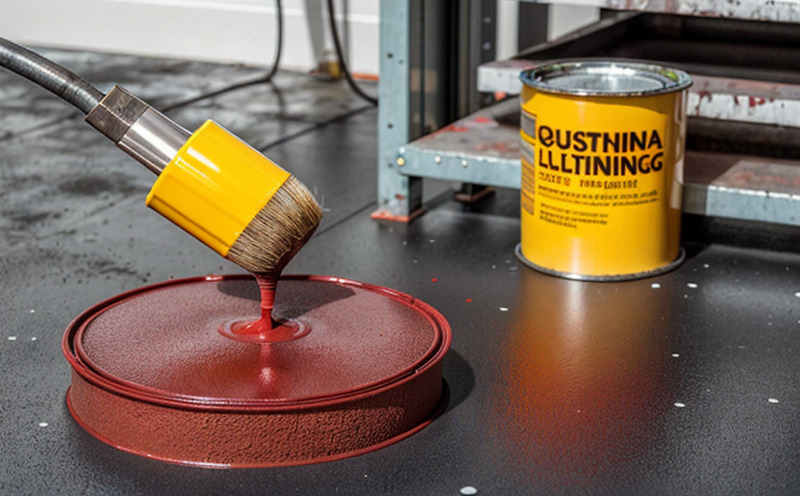ISO 1520 Cupping Resistance Testing of Coatings
The ISO 1520 cupping resistance test is a critical procedure used to evaluate the ability of industrial coatings, paints, and surface finishes to resist deformation under pressure. This test is particularly important in sectors where coatings are subjected to mechanical stress or where adhesion strength between different materials is crucial.
The ISO 1520 standard specifies the method for determining the resistance to cupping (or bulging) of a coating when a flat specimen is subjected to pressure. This test is widely used in industries such as automotive, aerospace, and construction where durability and reliability are paramount. By measuring how much a coated surface can be pressed before it cups or deforms, this test provides valuable insights into the performance of coatings under stress.
The cupping resistance test involves placing a flat specimen onto a rigid support and then applying pressure using a specified weight and duration. The amount of deformation is measured by comparing the initial height of the coating with the height after the application of the load. This measurement helps in assessing the quality and durability of the coating, ensuring that it meets the required standards for industrial applications.
The test procedure outlined in ISO 1520 is designed to simulate real-world conditions where coatings are likely to be subjected to mechanical stress. For instance, in automotive manufacturing, coatings on metal parts may experience pressure during assembly processes or from road bumps and potholes while the vehicle is in operation. In construction, coatings on steel structures might face similar challenges due to external forces.
The test apparatus used for ISO 1520 involves a rigid support plate with a flat surface that matches the dimensions of the coating specimen. A weight is placed on top of the coated area, and after a specified time, the amount of cupping is measured using precise instruments like micrometers or gauges. The test parameters such as load pressure, duration, and temperature must be carefully controlled to ensure consistent results.
Specimen preparation for this test involves selecting representative samples that accurately reflect the properties of the coating in question. This includes ensuring that the substrate is clean and free from contaminants, allowing the coating to adhere properly without interference. The coating thickness should also be consistent across all specimens to provide a fair comparison.
The results of ISO 1520 testing are typically reported as the maximum height of deformation (in millimeters) after applying the specified pressure for the given duration. These values help in assessing the cupping resistance of different coatings and can guide decisions on which coating to use in specific applications. For example, a higher value indicates better resistance to cupping, suggesting that the coating is more suitable for high-stress environments.
Understanding the results of ISO 1520 testing is crucial for quality managers, compliance officers, R&D engineers, and procurement professionals working in industrial manufacturing and processing. By ensuring that coatings meet or exceed specified resistance to cupping, these stakeholders can enhance product performance, reduce maintenance costs, and improve overall reliability.
In conclusion, the ISO 1520 cupping resistance test is an essential tool for evaluating the durability of industrial coatings in high-stress environments. By providing accurate measurements of coating deformation under pressure, this test supports critical decision-making processes across various sectors, ensuring that products meet stringent quality standards.
Applied Standards
The ISO 1520 cupping resistance test is based on international standards such as ISO 1520:2019. This standard provides precise guidelines for the testing procedure, ensuring consistency and accuracy across different laboratories. Compliance with these standards is crucial for obtaining reliable results that are comparable between various testing facilities.
The test apparatus used in this procedure must adhere to specific specifications detailed in ISO 1520. These include the dimensions of the rigid support plate, the weight used for applying pressure, and the duration of application. Deviations from these standards can lead to inaccurate results, making it imperative that all testing be conducted according to the prescribed methods.
The standard also specifies the acceptable tolerances for the measurement of cupping resistance. This ensures that any deformation observed is due to the applied pressure rather than variations in equipment or methodology. By adhering to these standards, laboratories can ensure that their results are valid and reliable.
Benefits
The ISO 1520 cupping resistance test offers numerous benefits for industrial manufacturing and processing operations:
- Enhanced Product Quality: By identifying coatings with superior cupping resistance, manufacturers can improve the overall quality of their products.
- Cost Savings: Reducing the frequency of maintenance and repairs due to coating failure leads to significant cost savings over time.
- Improved Durability: Coatings that exhibit high cupping resistance are more likely to withstand harsh environmental conditions, extending the life span of industrial equipment.
- Better Compliance: Testing according to ISO standards ensures compliance with international regulations and industry best practices.
Environmental and Sustainability Contributions
The ISO 1520 cupping resistance test plays a crucial role in promoting sustainability within industrial manufacturing processes. By ensuring that coatings are durable and resistant to deformation, this test helps reduce waste and the need for frequent replacements. This, in turn, contributes to lower environmental impact.
Using high-quality coatings with excellent cupping resistance can lead to reduced energy consumption during production and maintenance processes. Additionally, by extending the lifespan of industrial equipment, these coatings help minimize resource depletion and promote a more sustainable approach to manufacturing.
The test also supports the development of eco-friendly coatings that are not only durable but also have minimal environmental impact. By selecting coatings that pass stringent cupping resistance tests, manufacturers can contribute positively to global sustainability efforts.





